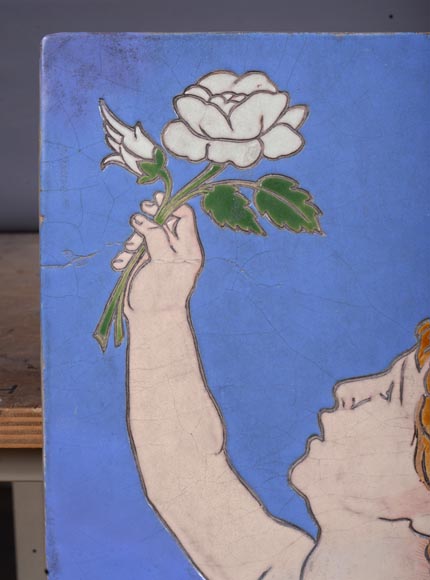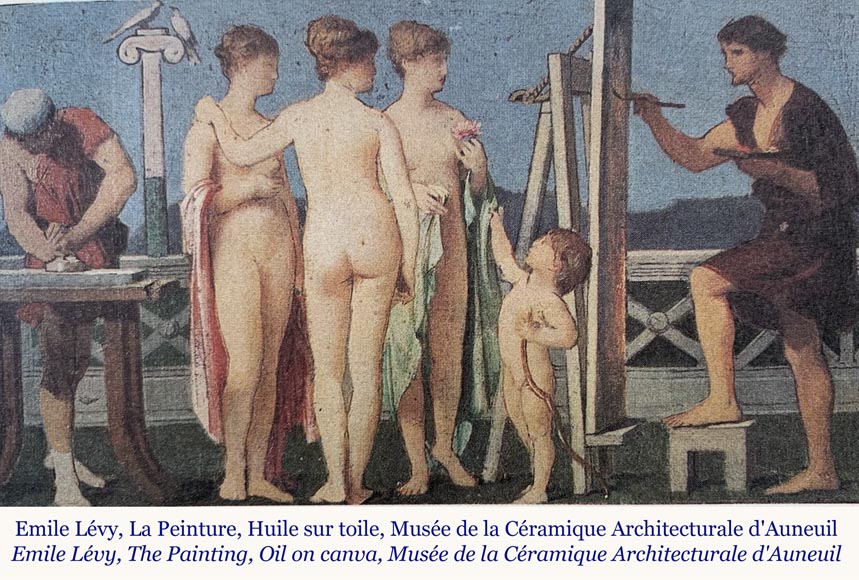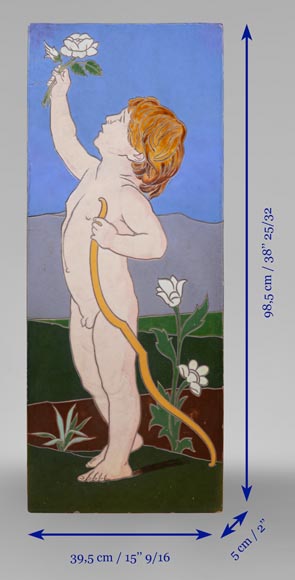Style Other / Ref.12841
Jules LOEBNITZ (1836 – 1895), Ceramic panel “Child with a flower”
Dimensions
Width 15'' ⅜ 39cm
Height 38'' ⅝ 98cm
Depth: 2'' 5cm
Origin:
France, circa 1880
This rectangular panel made of enameled ceramic made by Jules Loebnitz in the second half of the 19th century depicting a child holding a bow in one hand and a flower in the other one from a painting by Emile Lévy (1826 – 1890).
The Pichenot-Loebnitz factory was founded by Mr Pichenot, grand parent of Jules Loebnitz, in 1833. From 1841, Mr Pichenot had started the fabrication of uncrackable earthenware panels for mantel's interiors, showed with success during the Exhibition of 1844. Breaking with the traditional fabrication of white heating system, the Pichenot-Loebnitz factory, was one of the first to start the production of architectural earthenware decorations. In 1857, Jules Loebnitz, artist as much as an industrial, succeeded to his grand father and became director of the factory. He helped renovating the old mantels tiles during the restoration of the Castle of Blois before collaborating with the most important architects of his time Eugène Viollet-le-Duc, Laval, Charles Garnier, Just Lisch et Paul Sédille. Between the architect Paul Sédille and Jules Loebnitz, a true friendship was born that leads them to collaborate very closely from 1867. The architectural polychromy theoretician had met the man that has brought important progresses to French ceramic, allowing the making of important uncrackable earthenware panels.
Thus, during the Great Exhibition of 1878, Paul Sédille realized the door of the Palais des Beaux-arts, while Jules Loebnitz was in charge of the ceramic decoration of the facade, in order to advocate the renewed of architectural polychromy. For this purpose, he made a series of three panels taking as a model the paintings of Emile Lévy, kept today in the Musée de la céramique architecturale of Auneuil, depicting the Painting, the Sculpture and the Architecture, transposed to enamel by Lazar Meyer, a student of the painter.
The Painting depicts a scene on which we can see a man painting three naked women in the characteristic position of the Three Graces. Cupid, asking for a flower held by one of the woman, has most likely been used too as a model for the one we can see on our panel, as they have the exact same body position.
Indeed, the naked child with his red hair is standing by its profile on both panels, the left leg is out straight, the other is bend. He's holding in his left hand a bow and straight out his other hand to the sky, toward where he is looking. The difference is visible with the representation of the flower that the child is holding in our panel. On the contrary of the original painting, the background is abstract, the only décor is the flower behind the child.
We also find on one of the plate from La brique et la terre cuite by Pierre Chabt – book that has contributed to the success of the manufactory after it was published in the 1880’s – a panel depicting the same subject with a different background. This model is today kept in the Musée des Arts et Métiers in Paris.
Informations
Price: on request
Recommended for you :
Dimensions:
Height: 36
Dimensions:
Height: 8
Diameter: 41
Dimensions:
Width: 26
Height: 17
Depth: 15
Dimensions:
Height: 113
Diameter: 58
Dimensions:
Height: 116
Diameter: 48
Dimensions:
Diameter: 60
Dimensions:
Height: 20
Diameter: 37
Dimensions:
Width: 22
Height: 76
Depth: 22
Dimensions:
Width: 40
Height: 78
Depth: 24
Dimensions:
Height: 17
Diameter: 11
Dimensions:
Height: 26
Diameter: 36
























